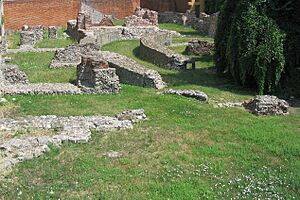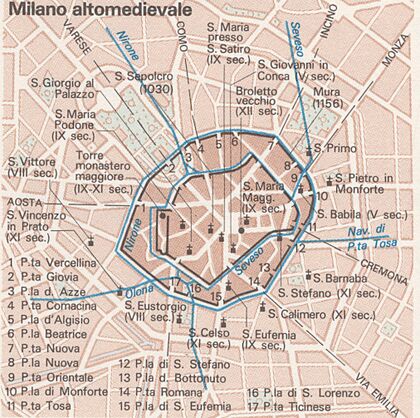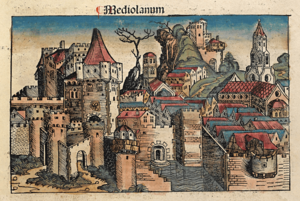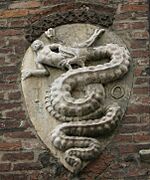History of Milan facts for kids
Milan, a famous city in northern Italy, has a very long and interesting history. It was first settled around 590 BC by a group of Celts called the Insubres. The Romans later conquered it in 222 BC and gave it the name Mediolanum. For a time, Milan was even the capital of the Western Roman Empire! In 313 AD, a very important event happened here: the Edict of Milan was issued, which allowed Christians to practice their religion freely.
Over the centuries, Milan saw many changes. During the Middle Ages, powerful families like the Visconti and Sforza ruled the city. Milan became a duchy and a key city during the Italian Renaissance, a time of great art and learning. It was involved in many wars and even suffered a terrible plague in the 1600s.
Later, Milan was ruled by Austria for a long time, but Napoleon made it the capital of his Kingdom of Italy for a while. In the 1800s, Milan played a big part in Italy becoming one united country. After World War II, the city grew quickly and became a global center for fashion and business. Today, Milan is known for its strong economy and modern developments, like the World Expo 2015.
Contents
Milan's Ancient Beginnings
Celtic tribe (Insubres) 590–222 BC
![]() Roman Republic 222–27 BC
Roman Republic 222–27 BC
![]() Roman Empire 27 BC–AD 395
Roman Empire 27 BC–AD 395
![]() Western Roman Empire 395–476
Western Roman Empire 395–476
![]() Kingdom of Italy 476–493
Kingdom of Italy 476–493
![]() Ostrogothic Kingdom 493–553
Ostrogothic Kingdom 493–553
![]() Eastern Roman Empire 553–569
Eastern Roman Empire 553–569
![]() Lombard Kingdom 569–774
Lombard Kingdom 569–774
![]() Carolingian Empire 774–781
Carolingian Empire 774–781
![]() Regnum Italiae 781–1014
Regnum Italiae 781–1014
![]() Holy Roman Empire 1014–1114
Holy Roman Empire 1014–1114
![]() Free Commune 1114–1259
Free Commune 1114–1259
![]() Lordship of Milan 1259–1395
Lordship of Milan 1259–1395
![]() Duchy of Milan 1395–1447
Duchy of Milan 1395–1447
![]() Golden Ambrosian Republic 1447–1450
Golden Ambrosian Republic 1447–1450
![]() Duchy of Milan 1450–1796
Duchy of Milan 1450–1796
![]() Transpadane Republic 1796-1797
Transpadane Republic 1796-1797
![]() Cisalpine Republic 1797–1802
Cisalpine Republic 1797–1802
![]() Italian Republic 1802–1805
Italian Republic 1802–1805
![]() Kingdom of Italy 1805–1814
Kingdom of Italy 1805–1814
![]() Kingdom of Lombardy–Venetia 1815–1859
Kingdom of Lombardy–Venetia 1815–1859
![]() Kingdom of Sardinia 1859–1861
Kingdom of Sardinia 1859–1861
![]() Kingdom of Italy 1861–1943
Kingdom of Italy 1861–1943
![]() Italian Social Republic 1943–1945
Italian Social Republic 1943–1945
![]() Kingdom of Italy 1945–1946
Kingdom of Italy 1945–1946
![]() Italian Republic 1946–present
Italian Republic 1946–present
Around 590 BC, a Celtic tribe called the Insubres settled the area and named it Medhelanon. An old legend says the city was founded by a chief named Belloveso. He supposedly found a "half-woollen boar," which became an old symbol for Milan. Even though this story is not historically proven, it shows how important wool production was in the area.
Milan Under Roman Rule
The Romans conquered Milan in 222 BC because it was in a very important location. They renamed it Mediolanum. When the Roman Empire was divided, Milan became the capital of the Western Roman Empire. This was around the late 3rd and early 4th centuries AD.
A key moment in Milan's history happened in 313 AD. The Emperors Constantine and Licinius issued the Edict of Milan. This important document officially ended the persecution of Christians, allowing them to practice their faith freely.
However, the 5th century brought difficult times. In 402 AD, the city was attacked by the Visigoths. Later, in 452 AD, Attila, the King of the Huns, attacked and destroyed much of Milan. This marked a period of decline for the city.
Milan in the Middle Ages

In 539 AD, the Ostrogoths conquered and destroyed Milan during a war against the Byzantine Empire. Then, in 569 AD, a Germanic tribe called the Lombards took over Milan. The region of Lombardy is named after them. Milan was less important during this time, as the Lombard capital was in a nearby city called Pavia.
In 774 AD, Milan surrendered to Charlemagne and the Franks. Charlemagne became "King of the Lombards" and made his capital in Germany. Milan did not do well under Frankish rule and became a less important county seat.
Rise of the City-State
By the 11th century, Milan and other Italian cities started to fight against the control of the Holy Roman Emperor. They wanted to be independent city-states. Milan became a powerful city-state, but it also fought often with its neighbors like Pavia and Como.
These conflicts sometimes led to destruction. In 1162, a fire destroyed Milan's food supply, forcing the city to surrender. After a period of peace, Milan grew strong again as a trading center. It gained more independence in 1183.
Powerful Families and Industries
During this time, Milan was governed by a local council. In 1259, a leader named Martino della Torre took control. He improved the city by paving streets and digging canals. However, his actions also caused financial problems and angered the people.
This led to a rivalry with another powerful family, the Visconti. The main industries in Milan during this period were making weapons and producing wool.
The Visconti family eventually took power in Milan. In 1395, Emperor Wenceslas made Milan a duchy, which was a higher status for the city. Gian Galeazzo Visconti became the first Duke of Milan. The Visconti family ruled Milan for about 150 years.
In 1447, the last Visconti duke died without a male heir. This led to the creation of the Golden Ambrosian Republic. This republic was named after St. Ambrose, a beloved patron saint of Milan. Both rival groups in the city worked together to create this republic. However, it only lasted a few years. In 1450, Francesco Sforza conquered Milan. His family, the Sforzas, then ruled the city and helped it become a leading center of the Italian Renaissance.
Milan in the Early Modern Era
The Italian Wars
From 1494 to 1559, Milan was caught up in a series of big conflicts called the Italian Wars. These wars involved many Italian city-states and later, most of Western Europe. Milan's ruler, Lodovico Sforza, invited the French king to Italy, hoping for an ally. However, this led to France wanting to control Milan.
After many battles, Milan eventually came under the control of Habsburg Spain in 1535. This meant that Spain ruled Milan for a long time. In 1556, the Spanish king gave his Italian lands, including Milan, to his son, Philip II of Spain.
The Great Plague
In 1629, a terrible event struck Milan: the Great Plague. It killed about 60,000 people out of a population of 130,000. This was one of the last major outbreaks of the plague that had affected Europe for centuries, starting with the Black Death.
Austrian Rule and Napoleon
In 1700, the Spanish royal family line ended. This led to a war called the War of the Spanish Succession. In 1706, the French lost control of northern Italy, and Milan came under the rule of the Austrian Habsburgs. This was confirmed by treaties in 1713–1714.
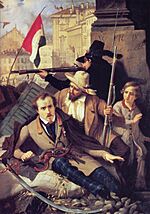
Later, Napoleon invaded Italy in 1796. He made Milan the capital of his Kingdom of Italy and was crowned in the city's famous Duomo cathedral. After Napoleon's rule ended, Milan and the region of Lombardy were returned to Austrian control in 1814. During this time, Milan became a very important center for opera music, with famous composers like Mozart and Verdi performing their works there.
Milan's Fight for Freedom
On March 18, 1848, the people of Milan rebelled against Austrian rule in what is known as the "Five Days." The Kingdom of Sardinia joined the rebels, and Lombardy voted to unite with Sardinia. However, the Austrians defeated the Sardinians and took back control of Milan.
Just a few years later, in 1859, Italian nationalists, with help from Sardinia and France, finally succeeded in removing the Austrians. After the Battle of Solferino, Milan and the rest of Lombardy joined the Kingdom of Sardinia. This kingdom soon gained control of most of Italy, and in 1861, it became the united Kingdom of Italy.
Early Industrial Growth
After Italy became one country, Milan quickly grew into the main business center of northern Italy. Many railways were built, making Milan a major train hub for both goods and people. This led to fast industrial growth, making Milan a key part of Italy's industrial region. It also became the country's leading financial centre.
Milan in Modern Times
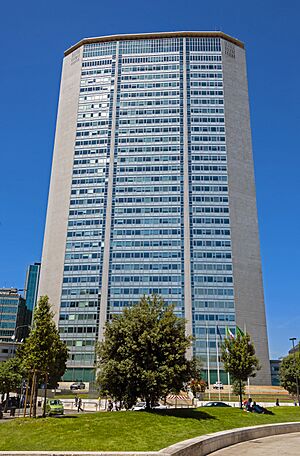
In 1919, Benito Mussolini's political group, the Blackshirts, held their first big meeting in Milan. Later, they started their March on Rome from Milan, which led to Mussolini taking power in Italy.
During World War II, Milan was heavily damaged by Allied bombings. When Italy surrendered in 1943, German forces occupied northern Italy. However, Italian resistance groups in Milan fought back. As the war ended, the resistance took control of the city and executed Mussolini.
Post-War Growth and Challenges
After World War II, Italy experienced a big economic boom. Milan's population grew rapidly, from 1.3 million in 1951 to 1.7 million in 1967. The city was rebuilt, and new, modern buildings like the Pirelli Tower were constructed.
However, the late 1960s and early 1970s were difficult times for Milan. The city saw a lot of street violence, worker strikes, and political problems. This period is sometimes called the "Years of Lead."
Fashion, Finance, and Renewal
In the 1980s, Milan became one of the world's top fashion capitals. Famous fashion houses like Armani and Versace made the city known globally. Tourism also increased, and Milan's stock exchange grew a lot. People started calling Milan "Milano da bere," meaning "Milan to drink," to describe its lively and successful atmosphere.
In the 1990s, Milan faced some political and financial challenges. However, in the early 21st century, the city began a major renewal. New business areas like Porta Nuova and CityLife were built. Milan has focused on developing its strengths in publishing, finance, fashion, technology, and tourism. The city's population has also started to grow again, showing its continued importance.
See also
- Timeline of Milan



